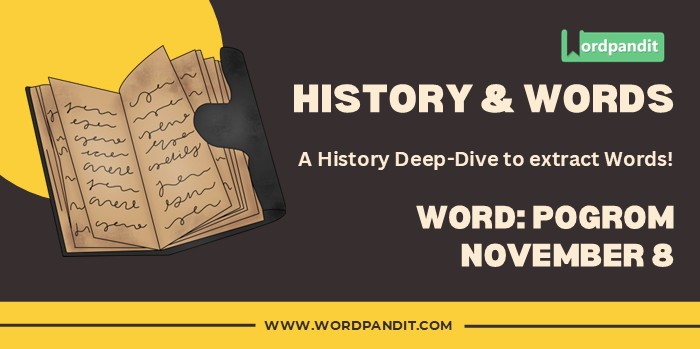History & Words: 'Pogrom' (November 8)
Welcome to 'History & Words.' 🌟 I'm Prashant, founder of Wordpandit and the Learning Inc. Network. This series combines my passion for language learning with historical context. Each entry explores a word's significance on a specific date, enhancing vocabulary while deepening understanding of history. Join me in this journey of words through time.
📚 Table of Contents
- Word of the Day
- Introduction
- Etymology
- Key Vocabulary
- Historical Context
- Timeline
- The Day's Significance
- Quote
- Modern Usage and Reflection
- Legacy
- Comparative Analysis
- Did You Know?
- Conclusion
- Further Reading
🔍 Word of the Day: Pogrom
Pronunciation: /pəˈɡrɒm/ or /ˈpɒɡrəm/ (puh-GROM or POG-rum)
🌍 Introduction
As we approach the anniversary of Kristallnacht (November 9-10, 1938), we examine the word "pogrom," which encapsulates one of humanity's darkest practices: organized violence against ethnic or religious groups. The term gained prominence during the anti-Jewish violence in the Russian Empire but has come to represent similar acts of organized persecution throughout history.
The word's history reflects centuries of systematic violence against minority groups, particularly Jewish communities in Eastern Europe. Understanding its origins and evolution helps us recognize and confront patterns of organized persecution.
The study of pogroms provides crucial insights into how systematic violence develops and the importance of preventing such events through education, awareness, and early intervention.
🌱 Etymology
The word "pogrom" comes from the Russian word "погром" (pogrom), meaning "devastation" or "riot," derived from the verb "громить" (gromit'), meaning "to destroy" or "to wreak havoc." The term entered international usage in the late 19th century during waves of anti-Jewish violence in the Russian Empire.
📖 Key Vocabulary
- 🔑 Persecution: Systematic mistreatment of individuals or groups, especially due to race or beliefs
- 🔑 Antisemitism: Prejudice, hostility, or discrimination against Jewish people
- 🔑 Kristallnacht: "Night of Broken Glass," the Nazi-organized pogrom of November 9-10, 1938
- 🔑 Systematized Violence: Organized and often officially sanctioned acts of aggression
- 🔑 Diaspora: The dispersion of any people from their original homeland
🏛️ Historical Context
Pogroms have occurred throughout history, but the term became widely used during the anti-Jewish violence in the Russian Empire from 1881 to 1884. These attacks often followed political or economic crises and were frequently encouraged by local authorities.
The late 19th and early 20th centuries saw waves of pogroms across Eastern Europe, forcing many Jewish families to flee to Western Europe, the Americas, and Palestine. These events significantly shaped Jewish migration patterns and community formation worldwide.
The most notorious pogrom of the 20th century, Kristallnacht, marked a turning point in Nazi Germany's persecution of Jews, transitioning from discrimination to systematic violence.
⏳ Timeline
- 1821: Odessa pogrom, one of the first documented in the modern era
- 1881-1884: First major wave of pogroms in Russian Empire
- 1903-1906: Second wave of Russian pogroms
- 1919-1921: Pogroms during Russian Civil War
- 1938: November 9-10 - Kristallnacht in Nazi Germany
- 1941: Iaşi pogrom in Romania
- 1946: Kielce pogrom in post-war Poland
- 1991: Anti-Armenian pogroms in Azerbaijan
🌟 The Day's Significance
November 8 serves as a day of remembrance and reflection, preceding the anniversary of Kristallnacht. This timing reminds us of how quickly systematic persecution can escalate into widespread violence.
The proximity to Kristallnacht's anniversary highlights the importance of recognizing early warning signs of organized persecution and the need for swift international response to protect vulnerable communities.
These events demonstrate how official sanction or passive acceptance of violence against minority groups can lead to escalating persecution.
💬 Quote
"Those who do not remember the past are condemned to repeat it."
- George Santayana, philosopher and poet
🔮 Modern Usage and Reflection
Today, the term "pogrom" has expanded beyond its original context to describe organized violent attacks against any ethnic, religious, or minority group. The word serves as a warning signal in discussions of ethnic and religious violence.
Understanding the dynamics of pogroms helps identify and prevent similar patterns of organized persecution in contemporary contexts.
🏛️ Legacy
The history of pogroms has profoundly influenced international law, human rights declarations, and genocide prevention efforts. It has shaped modern approaches to protecting minority rights and responding to ethnic violence.
The term's evolution reflects growing awareness of the need to identify and prevent organized persecution before it escalates into large-scale violence.
🔍 Comparative Analysis
While earlier usage specifically referred to anti-Jewish violence in Eastern Europe, modern usage encompasses various forms of organized ethnic or religious persecution. This broader application helps identify similar patterns of violence across different contexts and cultures.
💡 Did You Know?
🎓 Conclusion
The history of the word "pogrom" serves as a crucial reminder of humanity's capacity for organized violence and the importance of remaining vigilant against persecution in all its forms. Understanding this history helps us recognize and prevent similar patterns of systematic violence in the modern world.
📚 Further Reading
- 📘 "Pogrom: Kishinev and the Tilt of History" by Steven J. Zipperstein
- 📗 "The Origins of Nazi Violence" by Enzo Traverso
- 📙 "Anti-Jewish Violence: Rethinking the Pogrom in East European History" edited by Jonathan Dekel-Chen











